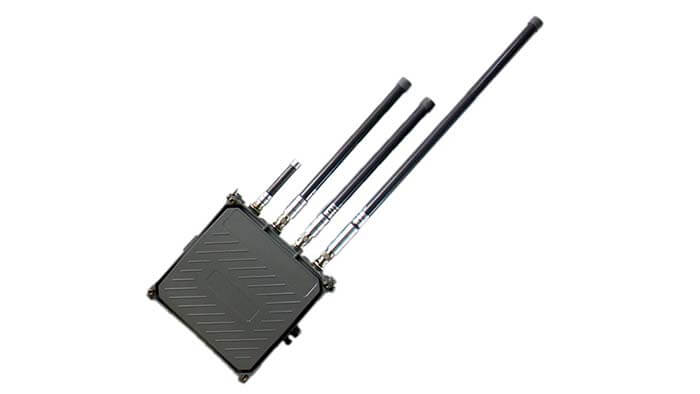What is a Lora gateway and what does it do?
LoRa gateways use different frequency extension factors and different frequency extension factors, and can therefore theoretically demodulate multiple frequency extension factors in the same channel. Gateways and web servers are connected via standard IP, and endpoints communicate with one or more gateways via a single hop.
What is a LoRa gateway?

A LoRa gateway is located at the core of a LoRa star network and is the information bridge between the terminal and the server (Server), and is the transceiver of multiple channels.
LoRa gateways are sometimes called LoRa base stations or LoRa concentrators, which have different definitions but are actually the same meaning.
LoRa gateways apply different spreading factors, two orthogonal sets of different spreading factors, and are therefore theoretically able to modulate and demodulate several data signals with different spreading factors in the same wireless channel.
The connection between the gateway and the cloud server is carried out according to the standard IP, and the terminal communicates with one or several gateways according to the single hop, and all the terminal communications are double communications, in addition to the system upgrade software remote control upgrade, etc.
What is a LoRa gateway characteristic?
What is a LoRa gateway classification?
The current gateway types and definitions are different.
For example, the different application scenarios, can be divided into the indoor gateway and outdoor gateway;
According to the communication mode, it can be divided into the full-duplex gateway and half-duplex gateway;
According to the design standard, it can be divided into a fully compliant LoRaWAN protocol gateway and a non-compliant LoRaWAN protocol gateway.
According to the design standard, it can be divided into a fully compliant LoRaWAN protocol gateway and a non-compliant LoRaWAN protocol gateway.
At this stage, the definition is not the same and the types of gateways are not the same. The international LoRa alliance released the specification technology of wireless network connection – LoRaWAN according to the LoRa protocol, and the release of this specification technology has promoted the LoRa technology to carry out large-scale networking solutions. At this stage, there are also several companies in China promoting the development trend of LoRaWAN technology.
What is a LoRa gateway capacity?
Gateway capacity refers to the ability of the gateway to receive the number of packets in a certain period of time.
Theoretically, LoRa gateways support the advantages of LoRaWAN’s high capacity, flexible networking, and low cost for large project deployment.
LoRa network can access thousands of nodes, and the number can be flexibly increased or decreased according to the project demand, with good network scalability.
Low component cost, free communication fee, low overall operation cost, and obvious advantages in large projects.
Theoretically, a single SX1301 chip has 8 channels and can receive up to 15 million packets per day in full compliance with LoRaWAN protocol.
If an application sends packets at a frequency of 1 packet/hour, a single SX1301 chip constitutes a gateway capable of accessing 62,500 end nodes.
Of course, this is only a theoretical value, and the number of terminals accessed by the gateway is ultimately related to the number of gateway channels, the frequency of packets sent by terminals, the number of packets sent bytes, and the spreading factor.
What is a LoRa gateway access points determinants?
The number of nodes accessed by LoRa gateways depends on the channel resources that LoRa gateways can provide and the channel resources occupied by a single LoRa terminal.
If the LoRa gateway adopts the Semtech standard reference design and the gateway adopts the SX1301 chip, the number of channels is fixed at 8 uplink channels and 1 downlink channel.
Once the number of physical channels is determined, the channel resources that the LoRa gateway can provide are also determined. (The number of channels varies by gateway design).
The channel resource occupied by a single LoRa terminal is consistent with the time the terminal occupies the channel, which is also closely related to the packet frequency, the number of bytes sent by the terminal, and the spreading factor of the LoRa terminal.
When the packet frequency and the number of packet bytes sent by a LoRa terminal rise, the time that the terminal occupies the channel for sending and receiving increases, and more channel resources are taken up.
When the LoRa terminal uses a larger spreading factor, the signal can travel farther, but at the cost of taking more time to deliver a unit byte of information.
What is a LoRa gateway terminal?
In addition to gateways, we also need to focus on LoRa terminals.
LoRa terminals are the components of a LoRa network and generally consist of devices such as LoRa modules and sensors. loRa terminals can be battery powered and can be located remotely.
Each LoRaWAN protocol-compliant endpoint can communicate directly with a LoRaWAN-compliant gateway to enable interconnection.
What is a LoRa gateway antenna?
The LoRa & LoraWan antenna gateway antenna includes so many antenna types such as PCB Lora antenna, Fiberglass Lora antenna, Rubber duck Lora antenna, Magnetic mount Lora antenna, etc.
The LoRa & LoraWan antenna gateway antenna mainly operates at 433 MHz, 868 MHz, 915 MHz, etc.
C&T RF Antennas Inc provides the LoRa antennas required for the LoRa terminal LoRa gateways.
Besides the Characteristics of the 6 Wireless Protocols article, you may also be interested in the below articles.
What Is The Core 5G NR Technology?




